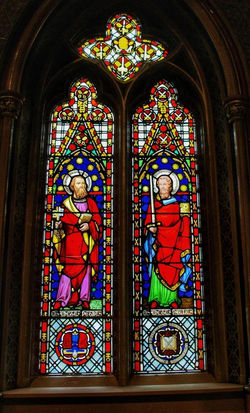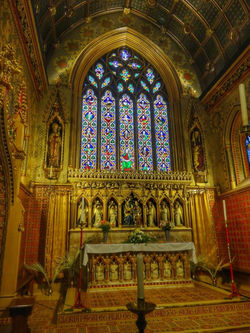You can follow the.lostplaces abandoned adventures
on Instagram @the.lostplaces and Twitter @peakdistrictand
Where the curiosity never ends…
St Giles, Cheadle
Perfect Cheadle...My consolation in all afflictions
St Giles is the church by which, fairly or unfairly, I compare all others. Before my first visit I had only seen glimpses of Pugin’s work in the Chapel and the Great Dining Hall of nearby Alton Towers. I had also read many descriptions of his sumptuous interiors, but until I walked through the doors of St Giles for the first time, they had lived in my imagination alone.
Located in the small town of Cheadle, Staffordshire, the first sight you will see of St Giles is its impressive 200-foot red sandstone steeple towering over the rooftops. The church was funded by John Talbot, the 16th Earl of Shrewsbury whose heraldry can be found throughout; most famously the golden lions that adorn the red west doors. The construction of the church began in 1841, and whilst completion was scheduled for 1845, due to delays and redesigns it didn’t open until a year later in September 1846.
Entering the church is in itself a magical experience, as initially you are met by relative darkness, the lights only activating when a coin is placed into them meter inside the door. But once the lights come on, the church comes alive in a riot of colour and exuberant patterns. Some might declare it too much, overwhelming even, but to me it’s perfect.


Nothing in St Giles is left unadorned, with every surface, pier, archway and step painted, stencilled or laid with Minton tile. But just when you think it cannot get any more spectacular you discover the chancel, glittering with gold. The theme here is the Glory of Heaven, and it certainly lives up to that theme, with a host of angels adorning the walls and a magnificent Jesse window by William Wailes.
Pugin took on the services of Wailes when he parted ways with his former stained-glass producer, William Willement, who he had believed had grossly overcharged for the windows of nearby St John’s, Alton. Wailes’ Newcastle workshop was one of the largest stained-glass firms in the country and, at one time, employed over seventy men.
He was originally a grocer and tea merchant by trade but, after studying stained glass production and design in Germany under Mayer of Munich, he established his own firm in 1841. Like those before him, his relationship with Pugin did not last, as all of the stained-glass production was eventually handed over to Hardman & Co.

Other examples of exquisite craftsmanship can be found in the work of Thomas Roddis, of the Sutton Coldfield firm of stonemasons. Pugin had been so enamoured with Roddis’ work at St John’s that he also commissioned him to create numerous elements for St Giles. Of these, the intricately carved alabaster high altar and reredos and stone pulpit are especially fine.
For me, St Giles is about as close as you can get to understanding and experiencing first hand Pugin’s thoughts, vision, and dreams for the future of Gothic. When you try to comprehend all the work, craftsmanship and love that has gone into creating this church, it's hard to even imagine how it was completed in only five years. Maybe that is why it feels so magical and why it will also forever be known as Pugin’s Little Gem.
If you would like to learn more about St Giles, I thoroughly recommend reading Perfect Cheadle by Michael Fisher,
which is an extremely interesting and comprehensive guide to the church.
Alternatively, a guidebook also written by Michael can be purchased at the church.
 |  |  |
|---|---|---|
 |  |  |
 |  |  |
 |  |  |
 |  |  |
 |  |  |
 |  |  |
 |  |  |
 |  |  |
 |  |  |
 |  |  |
 |  |  |
 |  |  |
 |  |  |
 |
